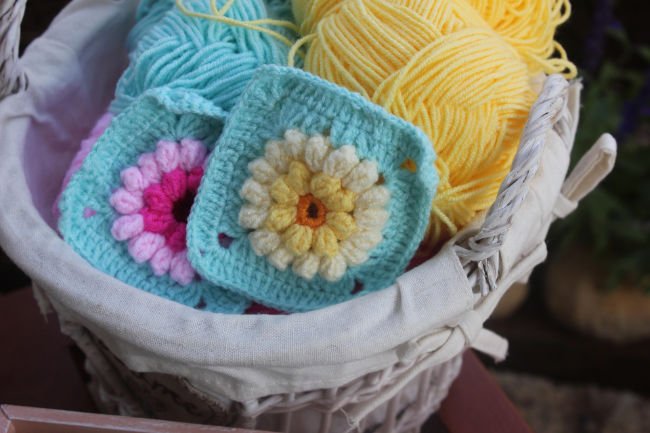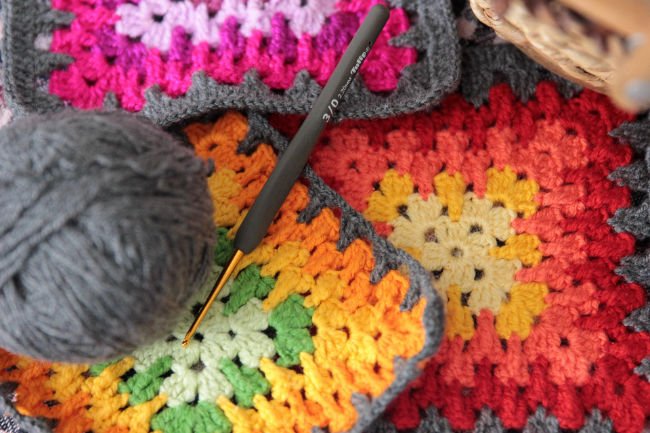Granny Squares in Crochet: the beginner’s guide
Looking for a fun, colorful crochet project with a retro twist? Stay put: granny squares are for you. But what are granny squares? In a nutshell, they’re the famous multicolored crochet squares that our grandmothers loved so much – and that are making a comeback today. I invite you to discover the world of granny squares, from their origins to their realization, not forgetting everything you can create with them.
Origin and history of granny squares
Where does the funny name granny square come from? To find out, we need to go back in time… Originally, our grandmothers collected the ends of balls of yarn from their projects to make simple crochet squares. Rather than waste these yarn scraps, they would assemble them into pretty doilies or patchwork blankets (the famous granny squares that used to hang out on Grandma’s sofa). That’s where the name comes from: granny and square.
Over time, these colorful little squares became a veritable DIY phenomenon, particularly in the 1970s with the bohemian wave. After falling out of fashion for a while, they’re now making a comeback thanks to their vintage charm. They’re everywhere, from fashion to home decor, and of course on social networks, where crocheters proudly share their creations!
Why do we love them?
So why have these crochet squares stood the test of time? And why do we still love them so much? Here are a few reasons for the timeless success of granny squares:
• Uncompromising flexibility: A granny square is like the chameleon of crochet. It can be tiny or gigantic, crocheted solo or in groups to form all kinds of projects. You can make a single small square into a coaster, or assemble 200 for a king-size blanket. Anything’s possible – just let your imagination run wild!
• Endless patterns: Contrary to popular belief, there’s not just one, but many granny squares. The classic pattern with its clusters of bridles is just the beginning. There are a multitude of variations: squares incorporating flowers, stars, geometric shapes… There are even granny squares with hearts or stylized figures! In short, it’s impossible to get bored: each square can be a new motif to explore.
• Color as a playground: If you like colorful projects, you’re in for a treat. Granny squares are perfect for using leftover balls of yarn and experimenting with color combinations. You can make a square all in shades of the same color, or a rainbow festival. Change color with each row for a vitaminized effect, or alternate two or three colors for a more graphic result. No rules, just fun!
Getting started: magic circles and diagrams
Let’s get practical! Where to start crocheting your first granny square? Two basic notions will help you a lot: the magic ring and reading a diagram.
The Magic Circle : Most granny squares start with a magic ring. If you’re unfamiliar with it, don’t worry: it’s simply an adjustable loop of yarn into which you crochet your first stitches, before pulling on the end to close the ring. This technique may seem a little tricky at first, but you’ll soon get the hang of it.
For practice, check out this magic circle tutorial on Yarn & Crochet, which explains step-by-step how to do it. Once you’ve mastered the magic circle, you’ll be able to use it for all your round projects.
Crochet diagrams: Another important basis is knowing how to decipher a diagram. It’s a diagram of the pattern with symbols instead of text. It can be scary at first, but once you get the hang of it, it makes a lot of sense. In fact, most granny square patterns are supplied as diagrams rather than written explanations. Let’s find out right away how to read these famous drawings!
Reading a diagram: the essential tip!
There’s no need to panic when it comes to deciphering a granny square diagram: you just need to understand where to start and how to read each turn. In general, the starting point is indicated in the center of the diagram (by a symbol or a small arrow). You then need to read the diagram from the center outwards, turn by turn, exactly as you would crochet your square. Each symbol corresponds to a specific stitch and the diagram legend will help you recognize them.
The secret is to follow the order of the symbols row by row. Once you get the hang of it, you’ll find that it’s much clearer than a long text of abbreviated explanations. What’s more, crochet diagrams are universal: you’ll be able to understand a pattern from the ends of the earth just with these little drawings!
Combination ideas: stitch, colors, visual effects
Now that we’ve mastered the basics of granny squares, let’s get creative. The great thing about granny squares is that you can vary almost any parameter to achieve different styles. Stitches used, choice of colors, visual layout: everything can change the look of your square. Here are a few ways to spice up your granny squares:
Play with stitch
We often think of classic granny squares made of bridles and loose stitches, but you can incorporate other crochet stitches to personalize your square. For example, replace the traditional groups of bridles with a popcorn stitch from time to time to give relief, or alternate a row of tight stitches with an openwork row to vary the textures. As long as you keep the square structure (four corners and a center), you can let your stitch creativity run wild – your granny will be all the more unique for it!
Daring colors
You can go multicolor freestyle: change color with each row for an ultra-vitamin rainbow effect. It’s perfect for using up all kinds of leftover yarn!
Another approach is to choose a limited palette of 2 or 3 colors that work well together and alternate them from one row to the next. For example, you could decide to alternate a neutral color with a bright one for each round, for a striking contrast, or on the contrary, stick to similar tones for a more harmonious look. By making each square in the same color range, you’ll achieve a beautiful, coherent whole.
Dare to use gradients: start your square with a dark color, then use lighter and lighter shades with each row (or vice versa). A granny square that lightens from the center outwards is visually stunning!
The great thing about granny squares is that even if you try a combination you don’t like, it’s no big deal: it’s just a little square. You can always make another one with different colors. These squares are perfect for risk-free experimentation!
Create stunning visual effects
When assembling your squares, think about the overall effect too: using the same color for the last row of each granny will give a regular, unified grid effect, while squares that are all different will create a cheerful patchwork. You can even arrange your square colors in such a way as to create a larger pattern when assembled (some people create real pixel-art designs with dozens of granny squares!). For example, by alternating light and dark squares along the length of a plaid, you can create a checkerboard pattern. With a little daring, you’ll see that you can achieve some very varied and original visual effects.

What to do with granny squares
Now that you know how to make them, what can you make with those famous granny squares? The short answer: just about anything you can crochet! These little square modules can be assembled or used on their own to create a ton of different projects. Here are a few ideas to inspire you:
• A plaid or blanket: This is THE classic. Assemble a multitude of squares to make a warm plaid for the living room or a baby blanket. It takes a little time to make, but the result is well worth the effort (and a family heirloom in the making!).
• Cushions: Tired of plain cushion covers? Hook together two large granny squares and use them as the sides of a square cushion cover. Guaranteed to look great on your sofa. Even with a single square in the center surrounded by plain fabric, you can customize a cushion in an original way.
• Clothes: Yes, granny squares can be worn with pride! You can make a sleeveless cardigan by assembling several squares (very fashionable at the moment), a colorful boho-chic sweater, a summer top, or even a colorful dress all in granny squares.
• Bags and accessories: a granny squares tote bag is pretty stylish, don’t you think? Simply crochet two large rectangles made from squares and sew them together to create your bag. You can also create pretty clutches, wallets or even a backpack by combining granny squares (and why not a bob-style hat made entirely of granny squares?).
As you can see, granny squares can do it all. Whether for decoration or fashion, these little modules can be adapted to your every crochet whim.
Tips for assembling squares
As you can see, granny squares can do it all. Whether for decoration or fashion, these little modules can be adapted to your every crochet whim.
• Plan the layout: Before you get out the needle or hook, take the time to lay out all your granny squares and organize them as you wish for your final work. Move them around until you achieve a harmony of colors and patterns that you like. This little preview prevents you from inadvertently ending up with two squares of the same color side by side. Once you’re happy with the arrangement, take a photo to remember it by, then move on to the assembly.
• Sewing or crocheting? Two methods are available: sewing with a needle or crocheting. Sewing by hand is almost invisible if you stitch in the edge stitches, while crocheting (with cast-on or tight stitches) is quicker and creates a little decorative relief. It’s up to you to choose the finish you prefer!
• Aligning the stitches: Make sure you match the stitches of two squares when you put them together. In general, each side of a granny has the same number of meshes as the side of the neighboring square, so simply join mesh by mesh (corner by corner) to avoid any misalignment. Good alignment guarantees a flat, bump-free end result.
• Joining thread and color: For discreet joining, use a thread of the same color as the last row of your squares, or a common neutral color. If your squares are very multicolored, many opt for a black, white or gray thread – it evens out and brings out the patterns without clashing. On the other hand, if you want to highlight the joints as a design element, you can choose a contrasting color to unite your squares. The joints will then form a visible and stylish grid.
In short, crocheting granny squares is super fun and rewarding. These little crocheted squares offer an infinite playground for expressing your creativity, while allowing you to create a host of varied and personalized projects. Don’t be afraid to experiment: mix stitches and colors, invent your own patterns… And if you make a mistake, don’t worry, we’ll undo it and start again! The important thing is to have fun with your crochet.
You’ll see, once you start making granny squares, it’s hard to stop. So it’s your turn: grab your hook, pick out your prettiest balls and have fun!
Discover our other crochet articles:
Crochet gauge swatches: Why and how to make them?
Discover why crochet swatches are essential to the success of your projects and learn how to make them and adjust your tension.
How to Read a Crochet Pattern: A Beginner’s Guide
Learning to crochet starts with understanding how to read a pattern. Discover how to decode common abbreviations, choose the right materials, and follow a project from start to finish.
10 Easy Crochet Accessory Ideas for Beginners
Looking for inspiration for your next crochet project? In this article, you’ll discover 10 trendy accessories that are easy to make, even if you’re just starting out. From colourful scrunchies to rucksacks, get all the creative ideas you need to express your talent while having fun.

by Katy
Creator of Yarn & Crochet







